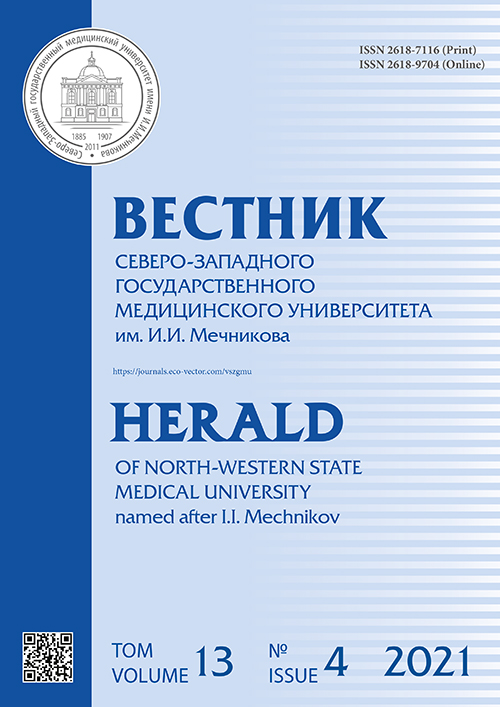N-acetyl-p-benzoquinonimine metabolite as a factor of possible neurotoxicity of paracetamol
- 作者: Vlasova Y.A.1, Zagorodnikova K.A.1
-
隶属关系:
- North-Western State Medical University named after I.I. Mechnikov
- 期: 卷 13, 编号 4 (2021)
- 页面: 79-84
- 栏目: Original research
- URL: https://journals.rcsi.science/vszgmu/article/view/99620
- DOI: https://doi.org/10.17816/mechnikov99620
- ID: 99620
如何引用文章
详细
BACKGROUND: Currently, the possible negative effects of paracetamol on the central nervous system are widely discussed in the modern scientific literature. The relationship between the intake of paracetamol during pregnancy by women and the risk of autism spectrum disorders in their children is being studied. However, such conclusions are often met with serious criticism as there are many questions about the methods of assessing behavioral disorders and processing research results. Therefore, experimental data obtained on neuronal cells may be a sufficient ground to confirm or refute assumptions about the neurotoxicity of paracetamol and its metabolites.
AIM: To study the effect of paracetamol and its metabolite N-acetyl-p-benzoquinonimine (NAPQI) on the neurons of the cerebral cortex of fetal rats.
MATERIALS AND METHODS: The study of the effect of paracetamol and its metabolite NAPQI on cell viability has been carried out by a method based on the reduction of 3-(4,5-dimethylthiazole-2-yl)-2,5-tetrazolium bromide (MTT).
RESULTS: It has been shown that during preincubation of neurons in the cerebral cortex of the rats with paracetamol at a concentration of 1 mg/ml for 24 hours and subsequent incubation with 0.3 mM hydrogen peroxide, both hydrogen peroxide and paracetamol itself reduce the viability of neurons. Joint incubation with paracetamol and hydrogen peroxide also reduces the viability of neurons. The same effect of paracetamol and its metabolite is observed with the joint preincubation of paracetamol or NAPQI and hydrogen peroxide.
CONCLUSIONS: Paracetamol as well its metabolite NAPQI reduce the viability of neurons in the fetal cortex of rats.
关键词
作者简介
Yuliya A. Vlasova
North-Western State Medical University named after I.I. Mechnikov
Email: Yuliya.Vlasova@szgmu.ru
ORCID iD: 0000-0001-5536-3595
Scopus 作者 ID: 6701810182
PhD, Cand. Sci. (Biol.), Assistant Professor
俄罗斯联邦, 47 Piskarevsky Ave., Saint Petersburg, 195067Ksenia A. Zagorodnikova
North-Western State Medical University named after I.I. Mechnikov
编辑信件的主要联系方式.
Email: ksenia.zagorodnikova@gmail.com
SPIN 代码: 4669-2059
MD, Cand. Sci. (Med.), Assistant Professor
俄罗斯联邦, 47 Piskarevsky Ave., Saint Petersburg, 195067参考
- Bandoli G, Palmsten K, Chambers C. Acetaminophen use in pregnancy: Examining prevalence, timing, and indication of use in a prospective birth cohort. Paediatr Perinat Epidemiol. 2020;34(3):237–246. doi: 10.1111/ppe.12595
- Chiew AL, Buckley NA. Acetaminophen Poisoning. Crit Care Clin. 2021;37(3):543–561. doi: 10.1016/j.ccc.2021.03.005
- Ni HM, McGill MR, Chao X, et al. Removal of acetaminophen protein adducts by autophagy protects against acetaminophen-induced liver injury in mice. J Hepatol. 2016;65(2):354–362. doi: 10.1016/j.jhep.2016.04.025
- Ramachandran A, Jaeschke H. Acetaminophen toxicity: Novel insights into mechanisms and future perspectives. Gene Expr. 2018;18(1):19–30. doi: 10.3727/105221617X15084371374138
- Tujios S, Fontana RJ. Mechanisms of drug-induced liver injury: from bedside to bench. Nat Rev Gastroenterol Hepatol. 2011;8(4):202–211. doi: 10.1038/nrgastro.2011.22
- Eke AC. An update on the physiologic changes during pregnancy and their impact on drug pharmacokinetics and pharmacogenomics. J Basic Clin Physiol Pharmacol. 2021. doi: 10.1515/jbcpp-2021-0312
- Stergiakouli E, Thapar A, Davey Smith G. Association of acetaminophen use during pregnancy with behavioral problems in childhood: evidence against confounding. JAMA Pediatr. 2016;170(10):964–970. doi: 10.1001/jamapediatrics.2016.1775
- Avrova NF, Sokolova TV, Vlasova YA, et al. Protective and antioxidative effects of GM1 ganglioside in PC12 cells exposed to hydrogen peroxide are mediated by trk tyrosine kinase. Neurochem Res. 2010;35(1):85–98. doi: 10.1007/s11064-009-0033-6
- Vlasova YuA, Golovanova NE, Beishebaeva ChR, et al. Study of neurotoxicity of paracetamol and its metabolite NAPQI (short message). Laboratory Animals for Science. 2021;4. doi: 10.29296/2618723X-2021-04-09
- Liew Z, Ritz B, Virk J, Olsen J. Maternal use of acetaminophen during pregnancy and risk of autism spectrum disorders in childhood: A Danish national birth cohort study. Autism Res. 2016;9(9):951–958. doi: 10.1002/aur.1591
- Ystrom E, Gustavson K, Brandlistuen RE, et al. Prenatal Exposure to Acetaminophen and Risk of ADHD. Pediatrics. 2017;140(5):e20163840. doi: 10.1542/peds.2016-3840
- Liew Z, Kioumourtzoglou MA, Roberts AL, et al. Use of negative control exposure analysis to evaluate confounding: an example of acetaminophen exposure and attention-deficit/hyperactivity disorder in Nurses’ Health Study II. Am J Epidemiol. 2019;188(4):768–775. doi: 10.1093/aje/kwy288
- Gou X, Wang Y, Tang Y, et al. Association of maternal prenatal acetaminophen use with the risk of attention deficit/hyperactivity disorder in offspring: A meta-analysis. Aust NZ J Psychiatry. 2019;53(3):195–206. doi: 10.1177/0004867418823276
- Bührer C, Endesfelder S, Scheuer T, Schmitz T. Paracetamol (Acetaminophen) and the developing brain. Int J Mol Sci. 2021;22(20):11156. doi: 10.3390/ijms222011156
- Rigobello C, Klein RM, Debiasi JD, et al. Perinatal exposure to paracetamol: Dose and sex-dependent effects in behaviour and brain’s oxidative stress markers in progeny. Behav Brain Res. 2021;408:113294. doi: 10.1016/j.bbr.2021.113294
- Aleksandrova AV, Senyavina NV, Maltseva DV, et al. p53- and Caspase-3-independent mechanism of acetaminophen effect on human neural cells. Bull Exp Biol Med. 2016;160(6):763–766. doi: 10.1007/s10517-016-3304-7
- Vlasova YuA, Zagorodnikova KA, Ivanova IS, Chukhno AS. The impact of oxidative stress on the neurotoxic effect of acetaminophen. Butlerov Communications. 2019;59(9):106–109. (In Russ.)
- Vlasova YuA, Zagorodnikova KA, Gajkovaya LB. Acetaminofen (paracetamol) v vysokikh koncentraciyakh snizhaet zhiznesposobnost’ kletok RS12. Proceedings of the Vserossijskaya nauchno-prakticheskaya konferenciya s mezhdunarodnym uchastiem “Profilakticheskaya medicina – 2019”; Sankt-Peterburg, Nov 14–15, 2019. Saint Petersburg; 2019. P. 110–115. (In Russ.)
- Schultz S, DeSilva M, Gu T, et al. Effects of the analgesic acetaminophen (paracetamol) and its para-aminophenol metabolite on viability of mouse-cultured cortical neurons. Basic Clin Pharmacol Toxicol. 2012;110(2):141–144. doi: 10.1111/j.1742-7843.2011.00767.x
补充文件










